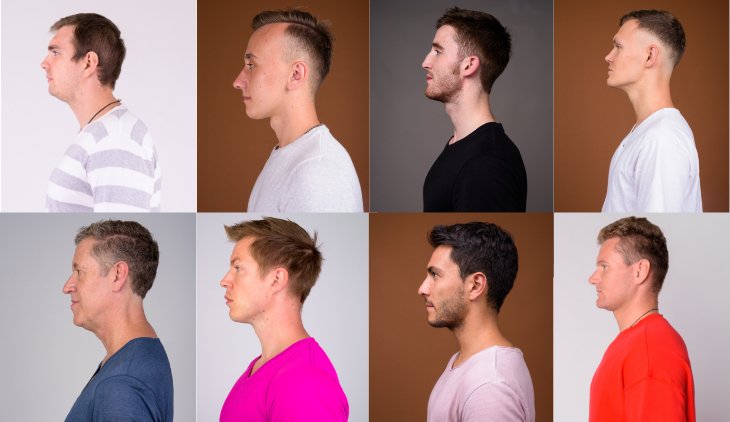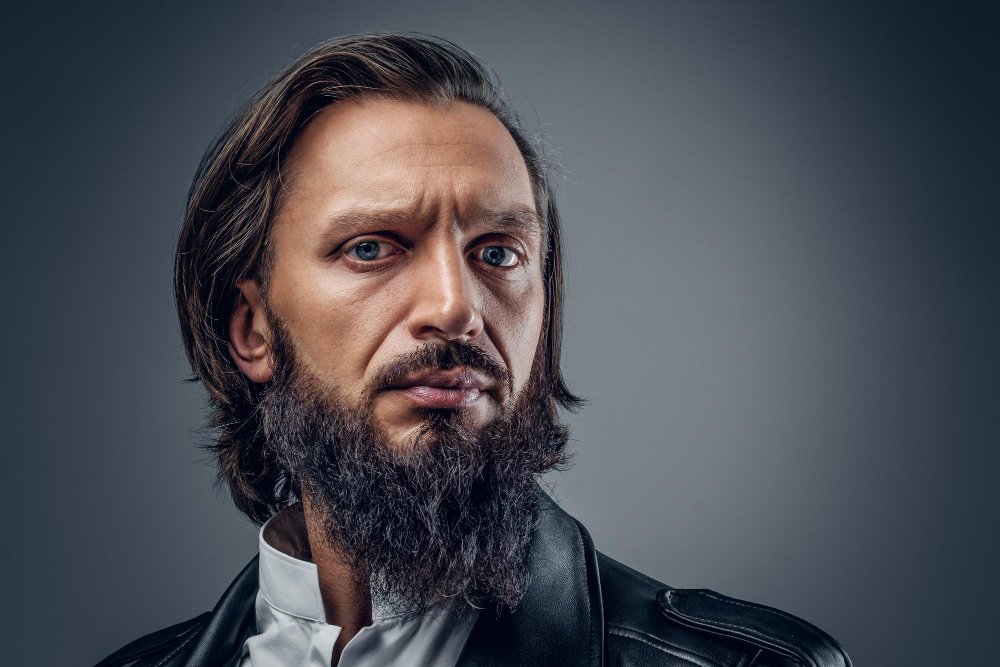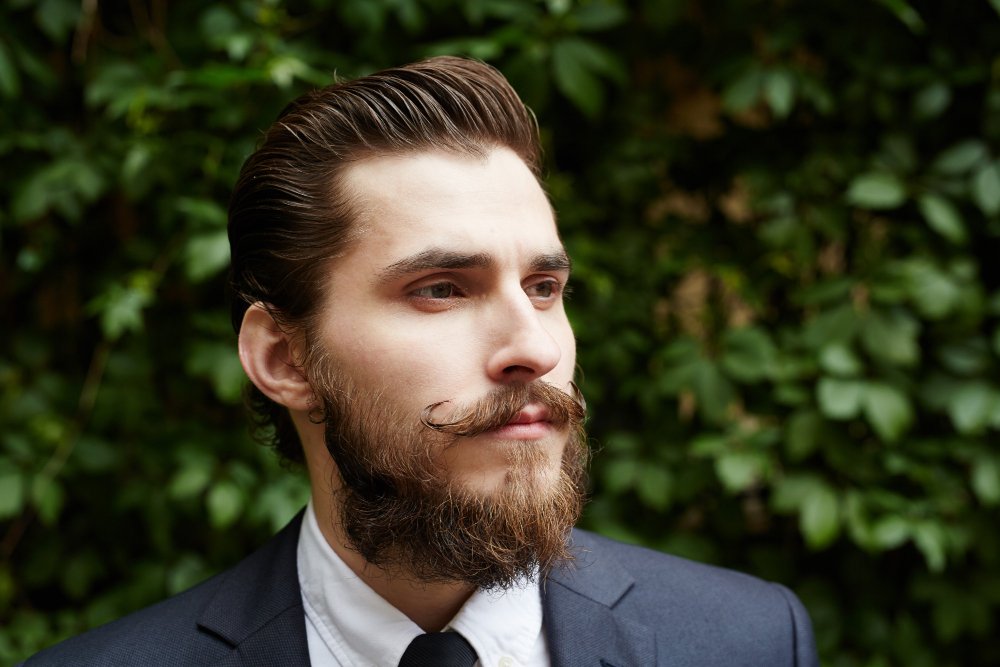Growing a beard isn't just about letting nature take its course; it's a personalized adventure requiring attention to the nuances of your facial landscape.
To cultivate the perfect beard, crucial considerations include the natural growth pattern, texture, and density, along with a mindful exploration of the primary and secondary features of the face, not to mention the defining border – the hairline. This article unfolds as your comprehensive guide, a roadmap to navigate the intricate labyrinth of beard growth.
Brace yourself for a detailed breakdown that explains the basics, exposing every aspect. The goal? Crafting a beard that's not just a statement but an authentic extension of your unique identity.
Important attributes about beards:
Growth Pattern
The growth pattern of a beard is a fundamental aspect that varies among individuals. Recognizing whether the facial hair grows in a straight, curly, or wavy pattern influences the chosen beard style. Understanding the natural growth direction helps in crafting a beard that complements the face shape and aligns with personal preferences.
Density
Beard density refers to the number of hair follicles per unit area, impacting the overall thickness and fullness of the beard. Individuals with a denser beard may have more styling options, allowing for voluminous and intricate designs. Those with less density might opt for styles that enhance their natural growth pattern while maintaining a polished and well-groomed look.
Texture
The texture of beard hair plays a significant role in its manageability and appearance. Coarse, fine, or medium textures can influence the way a beard feels and looks. Coarser hair may give a more rugged appearance, while finer hair can create a softer and more refined look. Understanding the texture helps in selecting grooming products and styling techniques tailored to the unique characteristics of the beard hair.
Now that you've got the lowdown on these beard attributes, you're armed with the knowledge to choose your perfect style when selecting a beard style, grooming routine, and maintenance practices. By embracing the natural growth pattern, working with beard density, and understanding texture nuances, individuals can curate a beard that not only enhances their facial features but also reflects their personal style.
Now let's dive a little deeper and explore some additional factors that play a crucial role in finding the perfect beard style for you.
Hair Texture:
The choice of beard styles can indeed be influenced by various hair qualities and patterns, including thickness, receding hairline, widows peak, and baldness.
Thickness of Hair:
Thick Hair: Individuals with thick hair can experiment with a variety of beard styles, from fuller beards to intricate designs. Maintaining the beard's thickness can create a bold and robust look.
For individuals with finer hair, there are still plenty of beard styles that can complement their facial features and enhance their overall appearance, opting for shorter styles like a goatee or well-groomed stubble is a popular choice. There is a lot of room for creativity with more distinctive styles such as the Van Dyke or Balbo.
Receding Hair Line:
A short Stubble Beard can complement a receding hairline, providing a neat and modern appearance without drawing excessive attention to the hairline. Even something like the Balbo Beard, can add definition to the chin area and draw attention away from a receding hairline.
Widows Peak:
Go goatee. A goatee that extends along the jawline looks great with a widows peak, creating a balanced and stylish look. Or add a mustache for a Circle Beard to provide more symmetry.
Bald:
You took the plunge and went fully bald. I commend you, sir. There are many options here. A beard that combines a mustache with a short, rounded beard can add character and style to a bald head, creating a cohesive and well-groomed appearance. But my personal favorite is a classic Full Beard. Embracing a full beard can provide a masculine look, offering a strong visual balance to a bald head. Trust me, I know.
Facial Features:
Primary features include the eyes, nose, and mouth, while secondary features include the brow-line, jawline, chin projection, and basic face shape.
Primary Features:
Eyes, Nose, Lips
Eye Spacing:
Like when getting fitted for glasses, knowing the spacing between the eyes plays a role in what kind of beard will fit the face best. The distance between your eyes influences the ideal sideburn thickness and eyebrow width.
If you have wider eye set, you may want to consider keeping the sideburns short and tight to create balance. If your eyes are closer together, then perhaps a thicker sideburn would be a more balanced look.
Nose Size and Shape:
When considering a beard in relation to one's nose, it's helpful to take into account various nose shapes to create a harmonious and balanced overall facial appearance.
Here are some considerations for different nose shapes:
Large vs Small
A Larger Nose may benefit with a fuller beard or a beard with some length that can help balance the proportions of a larger nose, drawing attention to the lower part of the face.
If the nose is more Bulbous, having a beard that is well-groomed can draw attention away from a prominent nose. Consider styles that provide structure without adding excessive volume.A Smaller Nose can be complemented by a variety of beard styles, like the goatee or a neatly trimmed beard to maintain balance without overwhelming facial features.
Nose Symmetry
A Straight Nosed individual can experiment with various beard styles, from short and tidy to longer, fuller options.
For those with a Crooked or Asymmetrical Nose, a well-groomed beard can help provide symmetry to the face. Avoid overly accentuating the asymmetry with an uneven beard shape.Short vs. Long
Long Nosed individuals benefit from shorter beard styles, such as a chin strap or a boxed beard, which can help balance the length of a prominent nose by drawing attention to the lower part of the face.
Shorter Noses may benefit from longer beard styles that can add vertical lines to the face, creating the illusion of a longer nose and balancing a shorter nose shape.
If one has a Wider Nose, a full beard or a beard that adds volume to the sides of the face can create a visual balance.Nose Tip Turn
If the nose has an Upturned, a variety of beard styles can work well, but avoiding a beard that points upward at the chin can help maintain a natural flow and balance.
If the nose has a Downturn to it, perhaps a beard with a clean, defined shape can complement a downturned nose. Consider styles that follow the natural contours of the face.
Lips:
Emphasize fuller lips by opting for a clean-shaven look or a beard, letting them take center stage in your facial hair style.
Thinner lips can enhance their appearance by complementing a beard with a mustache, creating a balanced and stylish facial hair ensemble.
Secondary Features
Brow-Line, Jawline, Chin Projection, Basic Face Shape
eyeBrows:
The transition between the eyebrows and the beard should appear seamless. If you have a strong brow line, choosing a beard style that connects well with the eyebrows can enhance facial continuity.
Here are 5 things to consider regarding the right beard for your eyebrows:
Eyebrow Thickness:
If you have thick, bold eyebrows, a fuller beard can complement the strong features, creating a harmonious and well-balanced look.Eyebrow Shape:
The natural shape of your eyebrows can guide your beard style. For example, if you have arched eyebrows, consider a beard style that complements the curvature.Eyebrow Position:
The position of your eyebrows in relation to your eyes and forehead can impact the overall facial symmetry. A well-groomed beard can enhance the alignment and balance of the facial features.Eyebrow Grooming:
Consistent grooming of eyebrows helps maintain a neat appearance. A well-groomed beard can complement the effort put into eyebrow maintenance, resulting in an overall polished look.Eyebrow Color:
Consider the color of your eyebrows in relation to your beard. While a contrast can be visually appealing, ensuring a complementary color scheme can create a cohesive and attractive facial appearance.
Jawline:
The Jawline is catagorized into 3 Gonial Grades (C, B, and A), as well as 3 main jaw shapes that are Flat or Straight, Round and Soft, or a Concave Jawline.
The Gonial Grades have a significant impact on the appearance and shape of the jawline, contributing to distinct masculine features. The jaw shape, in turn, plays a pivotal role in defining overall facial structure and masculine facial features.
Gonial Grades:
Grade C:
A C-grade gonial angle forms a round jawline, presenting as a straight line from the earlobe to the chin, contributing to a rounded face shape often associated with a long, narrow face and more delicate features due to less noticeable jaw muscle mass, adding a distinctive touch to masculine aesthetics.Grade B:
A B-grade gonial angle exhibits a noticeable, robust, and prominent jaw angle with well-defined characteristics, aligning closely with ideal jawline parameters and contributing to a well-shaped and prominently masculine face.Grade A:
Grade A jaw angle, exceptionally rare, nearly forms a perfect square, resulting in a 90-degree jawline, contributing to a fully developed and robust face strongly associated with a highly masculine look, more common in men and sought after for distinct contours, with some women considering jaw reduction surgery for a similar effect.
Jawline Shapes:
Different jawline types offer distinct facial profiles. A flat or straight jawline, associated with a Grade C gonial angle, is common in men, presenting as a straight line from ears to chin and often observed in those with a long, narrow face.
A round and soft jawline, characterized by a very obtuse gonial angle and a short ramus, is prevalent and favored among men. On the other hand, the concave jawline, marked by a defined gonial angle and near-perfect chin projection, is predominantly considered masculine yet appealing in both men and women for its prominence.
Chin Projection:
Chin projection refers to how far the chin extends forward in relation to the rest of the face. The Chin Projection Line is an imaginary line drawn perpendicular to the jawline, passing through the most prominent point of the chin. This line helps assess the degree of chin prominence or recession. This is where you may have heard terms like "a strong chin", or "a weak chin". Like Gonial Grades, there are Projection Grades as well:

grade C chin - where the chin recedes behind the chin projection line.
The Grade C jawline, known for its receding chin, stems from inadequate facial development, where the upper jaw and mandible lack proper alignment, causing the chin to slope backward toward the neck and not align with the upper lips and jaw.
grade B - where the chin extends to the projection line.
The second chin type extends to the projection of the upper lip, indicative of favorable facial development and alignment, resulting in aesthetically pleasing features and attractive faces.
grade A - the chin extends beyond the chin extension line.
The Grade A chin projection, where the chin extends beyond the upper lip, is a rare jawline type and, in certain instances, may indicate abnormal facial growth.
Face Shapes:
Cutting to the chase, we will start with an Oval face shape. Ultimately an Oval face shape can sport any style of beard. Congratulations if you are blessed with this chameleon of a face.
Wider Face Shapes:
Oblong
Opt for a shorter, tighter beard on the sides with a more angular outline to complement this face shape. This style works particularly well, enhancing the overall appearance, especially for individuals with a bald head.
Square
Consider a mid-length beard that is tighter on the sides and features a slightly angular outline. This style aims to elongate the face, providing a balanced and refined look.
Round
Choose a mid-length or longer beard with a slightly angular outline to elongate the face and create a leaner appearance. This beard style complements round face shapes, enhancing facial proportions.
Narrow Face Shapes:
Rectangular
Consider short or medium-length beards with a natural and soft outline for a flattering look that complements the rectangular face shape.
Heart
Opt for a fuller-shaped beard with a high, natural top line to prevent a narrowed appearance, enhancing the overall balance for those with a heart-shaped face
Diamond
Experiment with shaped stubble featuring a natural outline or a short, rounded beard to complement the unique contours of a diamond-shaped face
As you start your exploration into beard styling, remember that personal preference is of utmost importance. Your comfort and confidence should be the driving force in discovering your perfect look. Why not play around with different styles? Think of this as your beard playbook – but feel free to add your own chapters. And here's the beauty of it – no rules, just beard freedom!
For personalized insights, don't hesitate to consult with our experienced professionals at The Shave Cave.
Have fun expressing yourself through your beard, and, above all, do you – because at The Shave Cave, we believe in enhancing your unique features and celebrating individuality. Your beard journey is as limitless as your growth allows it.
Max









